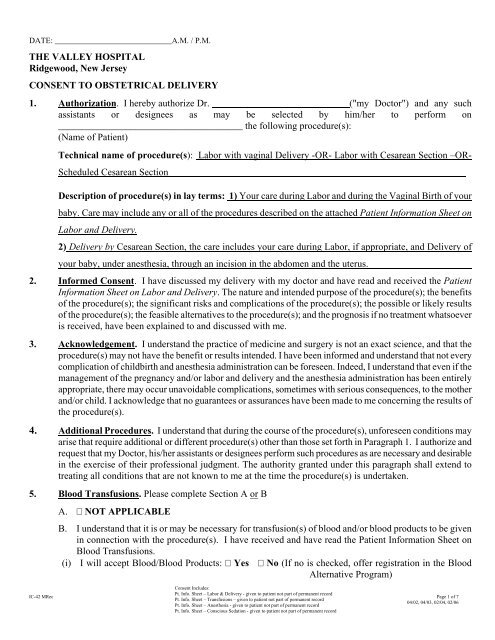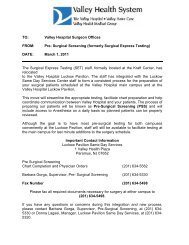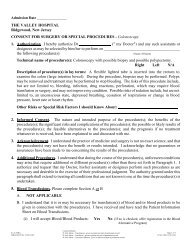Obstetrical Delivery Consent Form - Valley Hospital
Obstetrical Delivery Consent Form - Valley Hospital
Obstetrical Delivery Consent Form - Valley Hospital
Create successful ePaper yourself
Turn your PDF publications into a flip-book with our unique Google optimized e-Paper software.
DATE: _____________________________A.M. / P.M.THE VALLEY HOSPITALRidgewood, New JerseyCONSENT TO OBSTETRICAL DELIVERY1. Authorization. I hereby authorize Dr. ("my Doctor") and any suchassistants or designees as may be selected by him/her to perform on______________________________________ the following procedure(s):(Name of Patient)Technical name of procedure(s): Labor with vaginal <strong>Delivery</strong> -OR- Labor with Cesarean Section –OR-Scheduled Cesarean SectionDescription of procedure(s) in lay terms: 1) Your care during Labor and during the Vaginal Birth of yourbaby. Care may include any or all of the procedures described on the attached Patient Information Sheet onLabor and <strong>Delivery</strong>.2) <strong>Delivery</strong> by Cesarean Section, the care includes your care during Labor, if appropriate, and <strong>Delivery</strong> ofyour baby, under anesthesia, through an incision in the abdomen and the uterus.2. Informed <strong>Consent</strong>. I have discussed my delivery with my doctor and have read and received the PatientInformation Sheet on Labor and <strong>Delivery</strong>. The nature and intended purpose of the procedure(s); the benefitsof the procedure(s); the significant risks and complications of the procedure(s); the possible or likely resultsof the procedure(s); the feasible alternatives to the procedure(s); and the prognosis if no treatment whatsoeveris received, have been explained to and discussed with me.3. Acknowledgement. I understand the practice of medicine and surgery is not an exact science, and that theprocedure(s) may not have the benefit or results intended. I have been informed and understand that not everycomplication of childbirth and anesthesia administration can be foreseen. Indeed, I understand that even if themanagement of the pregnancy and/or labor and delivery and the anesthesia administration has been entirelyappropriate, there may occur unavoidable complications, sometimes with serious consequences, to the motherand/or child. I acknowledge that no guarantees or assurances have been made to me concerning the results ofthe procedure(s).4. Additional Procedures. I understand that during the course of the procedure(s), unforeseen conditions mayarise that require additional or different procedure(s) other than those set forth in Paragraph 1. I authorize andrequest that my Doctor, his/her assistants or designees perform such procedures as are necessary and desirablein the exercise of their professional judgment. The authority granted under this paragraph shall extend totreating all conditions that are not known to me at the time the procedure(s) is undertaken.5. Blood Transfusions. Please complete Section A or BA. NOT APPLICABLEB. I understand that it is or may be necessary for transfusion(s) of blood and/or blood products to be givenin connection with the procedure(s). I have received and have read the Patient Information Sheet onBlood Transfusions.(i) I will accept Blood/Blood Products: Yes No (If no is checked, offer registration in the BloodAlternative Program)<strong>Consent</strong> Includes:Pt. Info. Sheet – Labor & <strong>Delivery</strong> - given to patient not part of permanent recordIC-42 MRec Page 1 of 7Pt. Info. Sheet – Transfusions – given to patient not part of permanent record04/02, 04/03, 02/04, 02/06Pt. Info. Sheet – Anesthesia - given to patient not part of permanent recordPt. Info. Sheet – Conscious Sedation - given to patient not part of permanent record
(ii) In connection with my consent to transfusion(s) of blood, my Doctor has provided me with informationabout, and has discussed and explained the following:(a) The reason(s) for transfusion(s), a description of the transfusion(s), the benefits and significant risks ofthe transfusion(s), all alternatives including autologous, homologous and directed donation, as well as therisks and consequences of not receiving a transfusion(s).(b) That a blood transfusion is not always successful and that no guarantee or assurance has been made to meor anyone concerning the results of a transfusion, and that I may be subject to ill effects as a result ofreceiving blood and/or blood products.(c) That this consent applies to all transfusions I may receive during this hospitalization.6. Anesthesia. I have received and have read the Patient Information Sheet on Anesthesia and I consent to theadministration and management of such anesthesia as the anesthesiologist assigned to my procedure(s) deemsappropriate. I have also received and have read the Patient Information Sheet on Conscious Sedation and Iunderstand that conscious sedation may be administered by a doctor other than an anesthesiologist, or by anurse under the direction of a doctor, and I consent to the administration and management of such conscioussedation as the doctor deems appropriate. I have been informed of the risks most commonly associated withthe administration of anesthesia and conscious sedation. I am aware that complications from all forms ofanesthesia and conscious sedation are rare, but may occur.7. Specimen. I further consent to the examination and disposal of any specimen(s) removed in the performanceof the procedure(s), as well as for the use of any specimen(s) for the advancement of medical science andeducation at the <strong>Hospital</strong> or any other institution the <strong>Hospital</strong> may designate.8. Disposal of Umbilical Cord and Placenta. I consent to the hospital's disposal of the umbilical cord andplacenta, as it sees fit.9. Certification. By my signature below, I certify the following to be true:A. I have read and fully understand the information in this consent form.B. The information referred to in this consent form was explained to me.C. I have had enough time to discuss my condition and the procedure(s), including blood transfusions andanesthesia, with my Doctor, his/her associate or designee.D. All of my questions have been answered to my satisfaction.E. I believe I know enough about the procedure(s), blood transfusions and anesthesia, and do hereby give myconsent for surgery or special procedures.(Signature of Patient)_____________________________________(Witness to Signature(s))_____________________________________The above Procedures Have Been Fully Explained tothe Concerned Parties (Signature(s) of Physician(s))<strong>Consent</strong> Includes:Pt. Info. Sheet – Labor & <strong>Delivery</strong> - given to patient not part of permanent recordIC-42 MRec Page 2 of 7Pt. Info. Sheet – Transfusions – given to patient not part of permanent record04/02, 04/03, 02/04, 02/06Pt. Info. Sheet – Anesthesia - given to patient not part of permanent recordPt. Info. Sheet – Conscious Sedation - given to patient not part of permanent record
THE VALLEY HOSPITALRidgewood, New JerseyPatient Information Sheet on Labor and <strong>Delivery</strong>1. INTRAVENOUS-SOLUTIONS-used to maintain hydration during labor, as well as to provide accessfor various medications, blood or blood products, if needed. The most common complications associatedwith their induction include pain and bruising (hematoma) at the site, and, less frequently, phlebitis. Youhave the option of receiving a designated autologous blood transfusion or a homologous bloodtransfusion, if you have made arrangements in advance.2. FETAL MONITORING-used to maintain surveillance of the fetal heart rate and maternal contractions.(a) External Monitoring-involves the placement of elasticized belts and measuring devices on themother's abdomen. There are no known risks to this procedure.(b) Internal Monitoring-involves attachment of a small wire electrode to the presenting part of the fetus,in most cases, to the head, to obtain the most accurate reading of the fetal heart rate. The mostcommon complications of this procedure include a small mark on the site of the electrode and/orsuperficial infection at the puncture site.(c) Internal Maternal Contraction Monitoring-used to monitor the intensity, strength and duration ofcontractions by inserting a narrow plastic fluid-filled tube, through the vagina, into the uterus andattaching it to the maternal monitor. The risks of this procedure, although unlikely to occur, includeperforation of the uterus and infection.3. AMNIOTOMY-rupture of the bag of waters to induce or expedite labor, to provide access to the fetusfor internal monitoring and to assess the nature of the amniotic fluid. The procedure is accomplished byinserting a small, blunt plastic instrument inserted through the vagina and cervix to puncture the amnioticsac. The most common complication includes superficial scratches/abrasions to the presenting part of thebaby. The rare complication includes a prolapsed umbilical cord.4. VAGINAL DELIVERY-is the delivery of a child through the vaginal canal.5. EPISIOTOMY-an incision made in the perineum, the area between the vagina and the rectum, at the endof the second stage of labor to avoid tearing of the perineum and to facilitate delivery of the baby. Theincision is repaired after the delivery using absorbable suture material. The more common complicationsof an episiotomy include scarring or improper healing of the perineum. The rare complications includepainful intercourse, abnormal communication with the rectum and bladder or formation of a bloodcollection (hematoma) which may require an additional procedure to evacuate or drain it.6. DRUGS/MEDICATIONS:(a) Pitocin-used to cause, increase or maintain contractions of the uterus to facilitate labor. This drug isadministered intravenously via a solution through an electronic infusion pump. The risks of thismedication are over-stimulating of the uterus causing prolonged uterine contractions which in rarecircumstances may cause fetal distress and rarely may cause rupture of the uterus, which may result inexcessive bleeding.IC-42 MRec Page 3 of 704/02. 02/06
(b) Local Anesthetic Agents-are injected in the skin of the region of the episiotomy to provide anestheticfor the episiotomy or the repair.(c) Other Narcotics & Barbiturates-used during early labor to decrease the pain and anxiety associatedwith labor. The complications may include pain at the injection site, low blood pressure anddepression or drowsiness of the baby if it is delivered soon after administration of the medication.7. AMNIOINFUSION-used to replace fluids into the uterus for the treatment of certain fetal heart patternsand/or meconium stained amniotic fluid. The fluid is replaced through an Internal Maternal Contractionmonitor.8. FETAL SCALP SAMPLING-used to obtain a blood specimen from the fetus to determine the fetal pH,which is a measurement of fetal well-being. The sample is obtained by inserting an instrument throughthe mothers' vagina, making a small puncture in the fetal scalp and withdrawing a small amount of bloodthrough a narrow tube. The most common complications include bleeding and superficial infection at thesite of the puncture.9. INDUCTION OF LABOR-use of techniques and/or medicines that cause the cervix to thin (efface) anddilate and stimulate labor when delivery of the fetus is indicated for medical and/or obstetrical reasons.One common example is the use of prostaglandins in the vagina to soften the cervix.10. FORCEPS DELIVERY-used to facilitate delivery in the case of prolonged labor or fetal distress. Themost common complication of forceps delivery is a mark on the baby which is usually temporary.Occasionally, abnormal maternal bleeding (hemorrhage), vaginal lacerations which may require bloodtransfusions and extensive vaginal repair, and formation of a blood collection (hematoma), may occur.11. VACUUM EXTRACTION-a device, using a suction cup attached to the fetal head, for facilitatingdelivery. The most common risks associated with this procedure include swelling, a superficial mark or abruise (hematoma) on the baby's scalp.12. CESAREAN SECTION-removal of the fetus, under anesthesia, by means of an incision into the uterusin circumstances where vaginal delivery is not possible. The most common complications include thepossibility of abnormal bleeding (hemorrhage), formation of scar tissue, and the possibility of futurecesarean section deliveries. Rarely, a complication may jeopardize the life of the mother. There is nomedically acceptable alternative to a recommended Cesarean Section. An attempted vaginal birth mayjeopardize the lift of the mother or the child.IC-42 MRec Page 4 of 704/02. 02/06
THE VALLEY HOSPITALRidgewood, New JerseyPATIENT INFORMATION SHEETBLOOD TRANSFUSIONSDuring the course of your medical treatment it may become necessary for you to have a transfusion ofblood or a transfusion of a component of blood. Transfusions can be homologous (blood that comesfrom the community blood bank), directed (donations from relatives or friends) or autologous (donationsthat come directly from you).Autologous (self-donated) blood has the least risk of all. Directed donations are not recognized as beingany safer than ordinary bank blood donations.Autologous blood must be donated in advance of elective surgery. Directed donations also requireadvance notice. These options should be discussed with your Doctor.All community blood bank products are obtained from volunteer sources who do not receive anypayment for their blood. Before giving blood, each donor is screened. If relevant health problems arediscovered, the donor is not accepted. The blood from each donor undergoes testing, including tests forAIDS (HIV), hepatitis, and syphilis. The medical community feels that our modern knowledge andtechnology have made transfusions safer today than they have ever been in the past.There are risks from transfusions, but risks of serious or fatal complications are very rare. For instance,the risk of acquiring the AIDS virus through a transfusion is much less than it was several years agobecause of the available screening tests. The incidence of acquiring AIDS today through a transfusionhas been estimated at 1:2,000,000 1 which is probably much less than one's chances of being a fatality ina motor vehicle accident. Other risks include hepatitis, fever, hemolysis (a breakdown of red blood cellsdue to an immune reaction which may cause anemia and kidney injury), and heart failure due to anexcessive amount of fluids.Transfusion risks must be weighed against benefits, and criteria have been established to aid your Doctorin making a decision about whether or not to transfuse.In summary, the safest transfusion is autologous (self-donated), but autologous transfusions require theluxury of advance notice, and are usually suited only to elective surgery. While directed and communitytransfusions have more risk, the medical community is trying to make them safer than they have everbeen before. Your Doctor must make the decision to transfuse or not, based on medical science andjudgment.If you or your Doctor decide to utilize autologous and/or directed blood, please call the BergenCommunity Blood Center for further information at (201) 444-3900.IC-2 MRec Page 5 of 707/96,03/01,01/02,01/061 Reference: AABB Technical Manual, 15th Edition, 2005.
THE VALLEY HOSPITALRidgewood, New JerseyPATIENT INFORMATION SHEETON ANESTHESIAThe purpose of surgical anesthesia is to relieve pain during surgery through the use of various medications ordrugs known as anesthetic agents. Along with the delivery of the anesthetic agent, life support measures areoften undertaken in order to maintain the well-being of the patient. These measures might include theadministration of blood or blood products (unless such blood or blood products have been refused); use ofmedications and equipment to support the heart, lungs or other systems of the body; antibiotics (drugs used toprevent or treat infection); and medications to counteract disease states or correct imbalances.Surgical anesthesia may be general, regional or local with intravenous conscious sedation. The type ofanesthesia selected in a given case will depend on the medical condition of the patient, the nature of theprocedure to be performed, and the preferences of the patient and of the surgeon.General anesthesia is a method of surgical anesthesia in which the patient is rendered unconscious andinsensitive to pain (will be asleep) through the use of anesthetic agents administered by inhalation (breathing ananesthetic gas through a mask) and/or by intravenous injection (using a small tube (catheter) to place theanesthetic agent into a vein and, thus, into the patient's bloodstream). The anesthetic agent, the route ofadministration, the dosage, and the depth of general anesthesia are dependent on the nature of the surgery to beperformed, the medical condition of the patient, and other considerations. Endotracheal intubation, in which abreathing tube is placed into the windpipe, is often necessary. Occasionally, patients complain of a sore throat,nausea and/or vomiting after undergoing general anesthesia. Strokes, brain damage and heart attack are rarecomplications of general anesthesia.Regional anesthesia is a method of surgical anesthesia in which anesthetic agents are used to numb a group ofsensory nerve fibers in order to make an area of the body insensitive to pain. Sometimes a tourniquet is used onan arm or leg and an anesthetic agent is injected into a vein of that arm or leg. During this type of anesthesia asedative to relax and calm the patient during the surgery is used. Occasionally, for technical reasons, it is notpossible to produce this type of anesthesia or it is not completely satisfactory. When this occurs another type ofanesthesia, usually a general anesthetic, is added. Two of the commonly used types of regional anesthesia areepidural and spinal anesthesia.Local anesthesia with intravenous sedation is where a local anesthetic agent is injected into the site to beoperated on by the surgeon to block sensory nerves. This makes that area of the body insensitive to pain ornumb. During this type of anesthesia, a sedative to relax and calm the patient is often given intravenously.In epidural anesthesia an anesthetic agent is injected into the epidural space to anesthetize (numb) the legs,pelvis, abdomen, or other area of the body. With this type of anesthesia a small tube (catheter) is inserted intothe epidural space so that additional anesthetic agent can be injected as needed. Rare complications of epiduralanesthesia include infection and paralysis.In spinal anesthesia the lower part of the body is made insensitive to pain by injecting an anesthetic agent intothe fluid which bathes the spinal cord. Infrequently, a post-spinal headache may occur. Rare complications ofspinal anesthesia include infection and paralysis.On the day of surgery, your anesthesiologist will speak with you to answer any questions you may have. If youwish to speak with an anesthesiologist prior to this, please call the Anesthesiology Department at (201) 447-8700.IC-2 MRec Page 6 of 707/96,10/98, 01/02
THE VALLEY HOSPITALRidgewood, New JerseyPATIENT INFORMATION SHEET ONCONSCIOUS SEDATIONThis patient information sheet has been developed to explain conscious sedation.Conscious sedation is a controlled state of extreme relaxation often resulting in little memory of theprocedure. This type of sedation reduces pain and awareness of the procedure while allowing the patientto breathe on his/her own and to respond to verbal commands and/or gentle stimulation. Many times apatient will not even recall having spoken to the staff during the procedure. Conscious sedation allows apatient to tolerate the procedure by relieving anxiety, discomfort and/or pain. For procedures thatrequire children not to move conscious sedation will help them to remain still.Informed consent must be obtained before the procedure and before the patient receives conscioussedation. In children, the informed consent must be obtained from a parent or guardian of the childbefore conscious sedation is administered. A physician or a nurse may administer conscious sedation.The patient is monitored before, during and after the procedure.If the patient is going home, arrangements should be made for a responsible adult to take the patienthome.There are some risks with conscious sedation. The risk is dependent upon many factors including thetype of procedure and the medical condition of the patient. Fortunately, adverse events are rare.IC-2 MRec Page 7 of 7MB-4/99 01/02
















